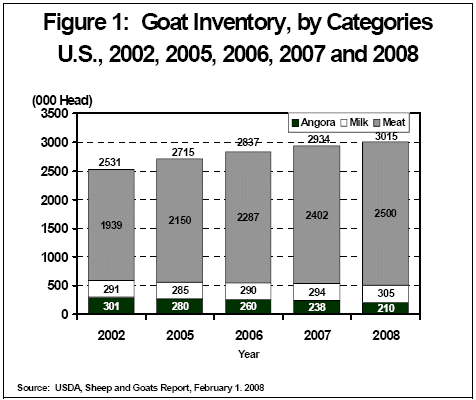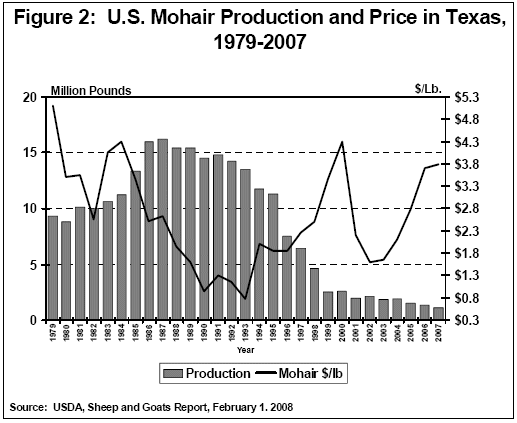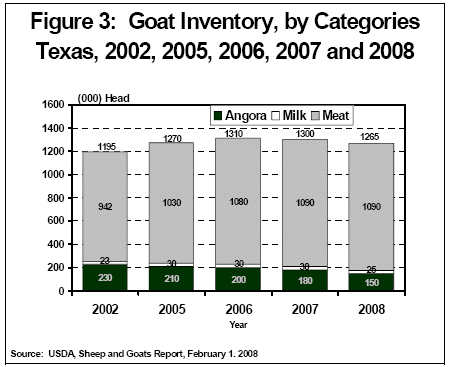AG-ECO NEWS
Vol. 24, Issue 5, February 25, 2008 – PDF version
Jose G. Peña
Texas AgriLife Extension Economist-Management
Total U.S. Goat Inventory Up 2.8%: Meat Goats Up 4.2%; Angora Goats Down 11.8%
While the U.S. all-goat inventory has grown steadily since 2001, the size of the Angora goat herd has steadily declined since the mid-90’s when the wool and mohair incentive program was terminated. According to USDA’s February 1, 2008 Sheep and Goats report, the all goat inventory in the U.S. on January 1, 2008, totaled 3.02 million head, up 2.8 percent from January 1, 2007. While the inventory of meat goats increased by 4.2 percent to 2.5 million head, the inventory of Angora goats decreased by 11.8 percent to 210,000 head. (See Figure 1). In January ‘06, it appeared that the liquidation of the U.S. Angora goat herd was slowing down as price bids for Angora kids and mohair improved and were probably influencing the slow-down of the Angora goat herd liquidation. But, the extreme drought in the southwestern part of the U.S. during 2006 and the continuing drought during fall ‘07, as well as the hardier, more profitable aspect of meat goats has worked against the retention of a large Angora goat herd, especially as the shearing labor force thins. 
The mix between Angora, meat and milk goats has changed dramatically during the last 16 years. Meat goats have replaced Angora goats recently at about 3.5:1 basis. According to USDA’s February 1, 2008 Sheep and Goats report, while the inventory of Angora goats decreased by 28,000 head on January 1, 2008, the inventory of meat goats increased by 98,000 head. The size the total U.S. goat herd is now over a million head larger than the 1.9 million head U.S. goat herd in 1992. The size of the U.S. Angora goat herd at 210,000 head on January 1, 2008 is only about seven percent of the 3.015 million head total U.S. goat herd. Meat goats now comprise about 83 percent of the U.S. goat herd, compared to 1992 when Angora goats accounted for close to 90 percent of the total U.S. goat herd.
Mohair Production Down, Prices Up
Mohair production dropped to 1.14 million pounds during 2007, down 15.8 percent from 1.354 million pounds produced during 2006, the lowest level since the last `high in 1987. After dropping to record lows during the mid-90’s, prices for mohair made an excellent recovery in 2000, weakened during 2002 but have been showing strength during the past five years. (See Figure 2). 
Almost all of the mohair is being exported. Currently, the industry is being supported by exporting the substantial accumulation of stocks stored in warehouses. More than twice the amount of the current annual production is being exported to countries like South Africa and the United Kingdom with the excess of production coming out of warehouse stocks. For example, 1.295 million pounds (clean) were exported in 2006, primarily to South Africa (72% of exports), the United Kingdom (12% of exports) and five other countries (11% of exports) when U.S. production was estimated at 1.354 million pounds (greasy).
Texas Leading State
Texas dominates the U.S. commercial goat industry with about 43 percent of the U.S. inventory. (See Figure 3). 
Texas continues to dominate the mohair industry, with about 79 percent of the 1.14 million pounds of mohair produced during 2007, followed by Arizona with 6.6 percent, New Mexico with 3.5 percent, California with 2.2 percent and about nine percent produced in eight other states.
